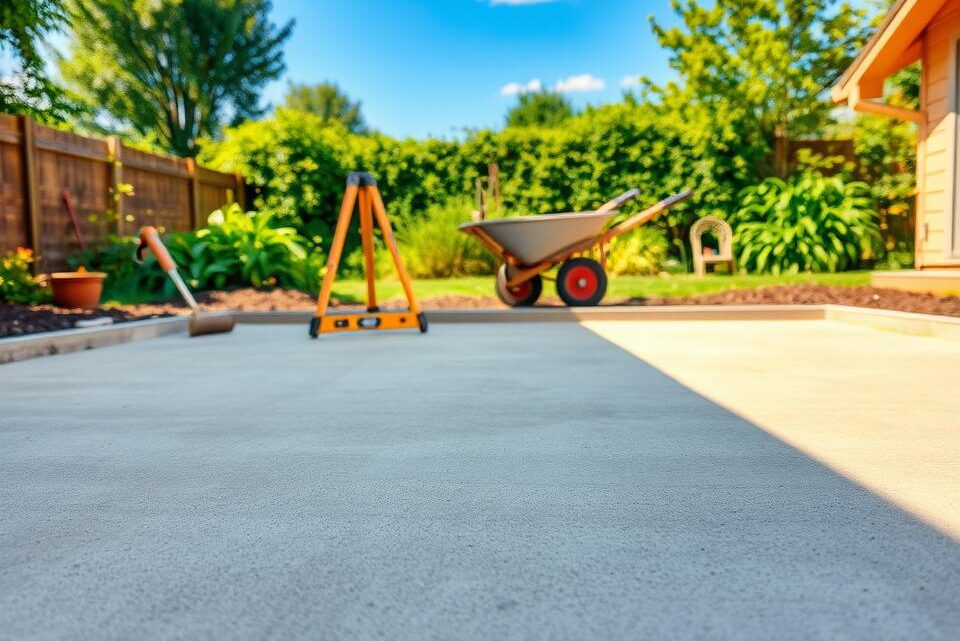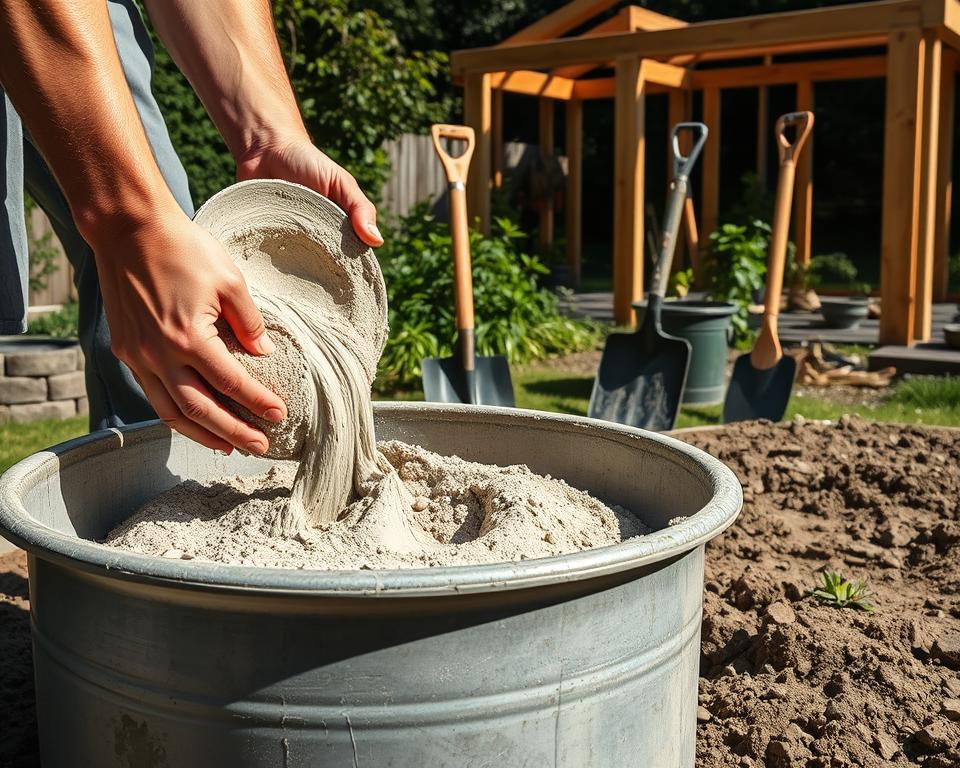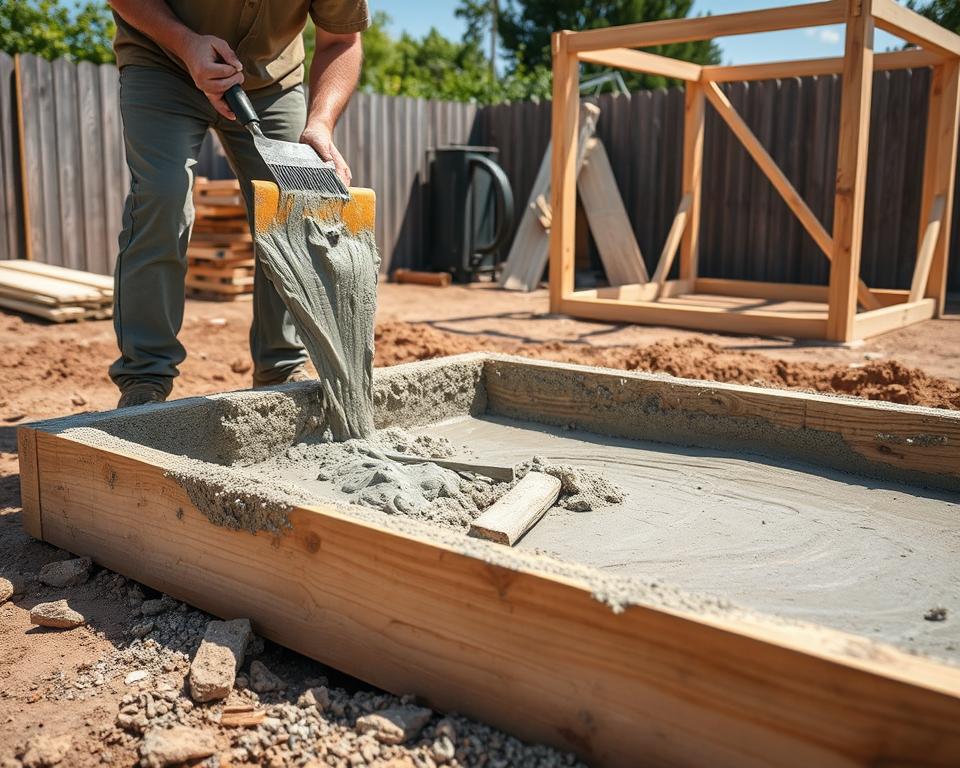How to Mix Concrete for the Foundation of a Garden Shed

Building a robust garden shed starts with a solid concrete foundation. DIY concrete mixing might seem challenging, but with the right guidance, anyone can create a stable base for their garden structure. A well-prepared concrete foundation ensures your shed remains level, protected from moisture, and capable of withstanding years of British weather.
Creating a garden shed foundation requires precision and careful concrete mixing techniques. Homeowners can achieve professional-quality results by understanding the fundamental principles of concrete preparation and application. This comprehensive guide will walk you through every critical step of crafting a durable concrete foundation.
Inhaltsverzeichnis
Key Takeaways
- Proper concrete mixing is essential for garden shed stability
- DIY concrete foundations can be achieved with careful planning
- Understanding mix ratios prevents structural weaknesses
- Moisture protection is crucial for long-lasting foundations
- Precision in preparation determines foundation quality
- Safety equipment is mandatory during concrete mixing
Essential Tools and Materials for Concrete Mixing
Preparing for a garden shed foundation requires careful selection of concrete tools, safety gear, and the right materials. This guide will walk you through the essential equipment and components needed to create a successful concrete mix.
https://www.youtube.com/watch?v=z-vGkb-VCdk
Hand Tools for Concrete Work
Selecting the right concrete tools is crucial for a smooth mixing process. The fundamental equipment includes:
- Sturdy wheelbarrow for transporting and mixing
- Flat-edged shovel for precise measurements
- Mixing hoe with a rigid blade
- Trowels for finishing and smoothing
Safety Gear Essentials
Protecting yourself during concrete work is paramount. Invest in quality safety gear to prevent potential injuries:
- Waterproof rubber gloves
- Safety goggles to shield eyes from splashes
- Dust mask to prevent inhalation of cement particles
- Steel-toed boots for foot protection
Cement Types and Aggregates
Understanding cement types and aggregates is key to creating a robust concrete mix. Different projects require specific combinations:
- Portland cement: Most common for general construction
- Rapid-hardening cement for quick-setting projects
- Coarse aggregates like gravel for structural strength
- Fine aggregates such as sand for smooth consistency
Precise Measuring Equipment
Accuracy is critical when mixing concrete. Use these measuring tools to ensure the perfect mix:
- Calibrated buckets for volume measurements
- Digital scale for precise ingredient weighing
- Measuring tape for checking volumes
- Water-resistant calculator for mix ratio calculations
“Proper preparation prevents poor performance in concrete mixing.” – Construction Professional
By investing in quality concrete tools, safety gear, appropriate cement types, and accurate measuring equipment, you’ll be well-prepared to create a solid foundation for your garden shed.
Calculating the Correct Amount of Concrete Needed
Getting your foundation measurements right is crucial when planning a garden shed project. A precise concrete calculator can save you time, money, and prevent wastage. Understanding how to determine concrete volume is essential for a successful build.

To calculate the exact concrete volume needed, you’ll want to follow these key steps:
- Measure the length and width of your foundation area
- Determine the desired foundation depth
- Multiply length × width × depth to get cubic metres
“Precision in measurement prevents poor performance in construction” – Professional Builder’s Handbook
Most concrete calculators recommend adding a 10% buffer to your measurements. This accounts for potential irregularities in ground levelling and ensures you don’t run short during pouring.
For garden shed foundations, typical depths range between 100-150mm. Professionals suggest using these standard measurements:
- Small sheds (2m×2m): Approximately 0.16 cubic metres
- Medium sheds (3m×3m): Approximately 0.36 cubic metres
- Large sheds (4m×4m): Approximately 0.64 cubic metres
Utilising a digital concrete calculator can streamline this process, providing instant volume calculations based on your specific project requirements.
Preparing the Foundation Site
Site preparation is a critical first step in creating a solid foundation for your garden shed. Proper groundwork ensures stability, prevents future structural issues, and extends the life of your construction project.
Ground Levelling Techniques
Achieving a perfectly level surface is essential for a successful foundation. Start by clearing the area of vegetation, rocks, and debris. Use these steps for effective ground levelling:
- Remove topsoil to create a clean, flat surface
- Use a spirit level to check ground evenness
- Employ a plate compactor to create a firm base
- Ensure a slight gradient for water drainage
Installing Formwork and Reinforcement
Formwork provides the crucial framework for your concrete foundation. Selecting the right materials and installation method is key to creating a strong base.
| Formwork Material | Durability | Cost |
|---|---|---|
| Wooden Boards | Moderate | Low |
| Plywood | High | Medium |
| Metal Forms | Very High | High |
For reinforcement, steel mesh or rebar provides additional strength to prevent cracking and improve the foundation’s structural integrity.
Moisture Barrier Installation
A moisture barrier is crucial in preventing water penetration and protecting your foundation from potential dampness. Polyethylene sheeting offers an effective solution, creating a protective layer between the ground and concrete.
- Choose a high-quality, thick polyethylene sheet
- Ensure complete ground coverage
- Overlap edges by at least 15 centimetres
- Seal seams with waterproof tape
Understanding Concrete Mix Ratios

Creating a robust foundation for your garden shed starts with understanding concrete mix ratios. The right cement-sand-aggregate ratio determines the strength and durability of your concrete structure.
Different projects require specific concrete mix ratios based on their strength requirements. For a typical garden shed foundation, you’ll want a mix that provides adequate support while remaining cost-effective.
“The key to a successful concrete foundation lies in precision and balance of ingredients.”
Standard concrete mix ratios typically follow these guidelines:
- General purpose: 1:2:4 (cement:sand:aggregate)
- High-strength applications: 1:1.5:3 ratio
- Lightweight projects: 1:3:5 mixture
| Mix Ratio | Compressive Strength | Best Used For |
|---|---|---|
| 1:2:4 | 3000 PSI | Garden shed foundations |
| 1:1.5:3 | 4500 PSI | Heavy-duty structures |
| 1:3:5 | 2000 PSI | Light landscaping |
Selecting the appropriate concrete mix ratio depends on multiple factors including local climate, soil conditions, and specific structural requirements. Always consult local building regulations to ensure your foundation meets required standards.
Precision in measuring your cement-sand-aggregate ratio will guarantee a strong, long-lasting foundation for your garden shed.
How to Mix Concrete for the Foundation of a Garden Shed
Creating a strong foundation for your garden shed starts with mastering the concrete mixing process. Precision and careful attention to detail will ensure a durable and reliable base that supports your structure for years to come.

Step-by-Step Mixing Process
The concrete mixing process requires methodical preparation and careful execution. Follow these essential steps to create the perfect concrete mix:
- Gather all necessary materials and protective equipment
- Measure dry ingredients precisely
- Mix cement, sand, and aggregates thoroughly
- Gradually add water while mixing
- Check concrete consistency regularly
Water-to-Cement Ratio Guidelines
Achieving the right water-cement ratio is crucial for concrete strength. Too much water weakens the mixture, while too little prevents proper binding. Typically, a ratio of 0.4 to 0.6 works best for most garden shed foundations.
Achieving the Right Consistency
Concrete consistency determines the quality of your foundation. The ideal mix should:
- Hold its shape when squeezed
- Spread easily without segregating
- Look smooth and uniform
- Feel like thick, wet clay
Pro tip: When you can form a ball of concrete that holds its shape without crumbling, you’ve reached the perfect concrete consistency.
Proper Concrete Pouring Techniques

Concrete pouring requires careful planning and precision to ensure a strong, durable foundation for your garden shed. The success of your project depends on executing the right techniques during the crucial pouring stage.
Begin by preparing your work area and gathering all necessary tools. Concrete pouring is time-sensitive, so having everything ready beforehand is critical. You’ll want multiple people to help, as working with wet concrete can be challenging for one person.
- Use a sturdy wheelbarrow for transporting concrete
- Work quickly to prevent partial setting
- Distribute concrete evenly across the foundation
Consolidation techniques play a vital role in creating a solid foundation. Use a concrete rake or shovel to spread the mixture uniformly. Tamping helps remove air pockets and ensures a dense, compact surface. For larger projects, consider using a concrete vibrator to improve compaction.
Finishing methods are equally important for achieving a smooth, level surface. Use a long-handled float to level the concrete, working from the edges towards the centre. Smooth out any imperfections carefully to create a professional-looking finish.
- Use a straight-edged float for initial levelling
- Create a slight slope for water drainage
- Avoid overworking the concrete surface
Remember that timing is crucial during concrete pouring. Work methodically but swiftly to prevent premature setting or uneven distribution. The right consolidation techniques and finishing methods will ensure a robust foundation for your garden shed.
Ensuring Proper Curing and Setting
Concrete curing is a critical process that determines the strength and durability of your garden shed foundation. Understanding the nuanced factors that influence concrete setting will help you achieve optimal results.

The success of concrete curing depends on carefully managing two key elements: temperature effects and moisture control. These factors significantly impact the concrete’s final strength and structural integrity.
Temperature Considerations for Concrete Curing
Temperature plays a vital role in concrete setting. The ideal curing temperature ranges between 10°C and 25°C. Extreme temperatures can compromise the concrete’s quality:
- Low temperatures (below 4°C) slow down chemical reactions
- High temperatures (above 35°C) accelerate moisture evaporation
- Sudden temperature fluctuations can cause cracking
Moisture Control Methods
Proper moisture control is essential for effective concrete curing. Maintaining consistent moisture prevents premature drying and ensures maximum strength development.
| Moisture Control Method | Effectiveness | Duration |
|---|---|---|
| Water Misting | High | 7-10 days |
| Plastic Sheeting | Medium | 5-7 days |
| Curing Compounds | High | 14-21 days |
By implementing these moisture control techniques, you’ll create an optimal environment for concrete curing, ensuring a robust foundation for your garden shed.
Common Mistakes to Avoid
Concrete mixing requires precision and careful attention to detail. Understanding common concrete mixing errors can help you avoid costly mistakes and ensure a high-quality foundation for your garden shed.
Successful concrete mixing and troubleshooting depend on recognising potential pitfalls before they become serious problems. Quality control starts with knowing what to watch out for during the mixing and pouring process.
- Adding excessive water weakens concrete strength
- Inadequate mixing creates uneven concrete consistency
- Poor site preparation compromises foundation stability
- Incorrect aggregate proportions reduce durability
Professional contractors recommend carefully measuring ingredients and maintaining consistent mixing techniques to prevent structural issues.
| Concrete Mixing Error | Potential Consequences | Prevention Strategy |
|---|---|---|
| Overwatering | Reduced compressive strength | Use precise water-to-cement ratio |
| Insufficient mixing | Uneven material distribution | Mix thoroughly for 3-5 minutes |
| Temperature extremes | Rapid setting or delayed curing | Work during moderate temperatures |
“Attention to detail separates amateur DIY projects from professional-quality results.” – Construction Engineering Handbook
By understanding these potential concrete mixing errors and implementing proper troubleshooting techniques, you’ll create a robust and long-lasting garden shed foundation.
Foundation Waterproofing and Protection
Protecting your garden shed foundation from water damage is crucial for its long-term durability and structural integrity. Foundation waterproofing goes beyond simple construction – it’s an essential investment in your project’s future.
Water can be a significant threat to concrete structures, causing potential damage and reducing the lifespan of your foundation. Understanding damp-proofing solutions becomes critical in maintaining the structural quality of your garden shed base.
Effective Damp-Proofing Solutions
- Apply specialised waterproof membranes along foundation walls
- Use high-quality concrete sealants designed for exterior applications
- Create proper drainage systems around the foundation perimeter
- Install moisture barriers beneath concrete surfaces
Long-term Concrete Maintenance Strategies
Concrete maintenance requires consistent attention and proactive care. Regular inspections can help identify potential issues before they become significant problems.
- Conduct annual foundation inspections
- Check for hairline cracks or structural changes
- Reapply sealants every 3-5 years
- Ensure proper water drainage around the foundation
By implementing these foundation waterproofing techniques, you’ll protect your garden shed investment and ensure a robust, long-lasting structure that withstands environmental challenges.
Conclusion
Completing your garden shed foundation represents a significant milestone in your DIY project. By mastering concrete mixing techniques, you’ve created a robust base that will support your structure for years to come. The skills you’ve developed in understanding mix ratios, pouring methods, and curing processes are valuable assets for future home improvement endeavours.
Your DIY foundation journey demonstrates that with careful planning, precise measurement, and patient execution, anyone can achieve professional-grade results. The concrete mixing success you’ve experienced will serve as a solid groundwork for constructing a sturdy and reliable garden shed that can withstand British weather conditions.
Remember that each step of the foundation preparation—from site levelling to moisture barrier installation—contributes to the overall structural integrity. Your attention to detail and commitment to following best practices will ensure a long-lasting garden shed project that you can be proud of.
As you move forward with your shed construction, take a moment to appreciate the skill and dedication you’ve invested. Should you require additional guidance or wish to share your experience, local hardware stores and online DIY communities are excellent resources for further support and inspiration.
FAQ
What is the ideal concrete mix ratio for a garden shed foundation?
For a typical garden shed foundation, a standard mix ratio is 1:2:3 – one part cement, two parts sand, and three parts aggregate. This provides a good balance of strength and workability. However, the exact ratio can vary depending on your specific soil conditions and local building requirements.
How much water should I add to my concrete mix?
The water-to-cement ratio is crucial. Generally, aim for about 0.4 to 0.5 parts water to one part cement. The mix should be moist enough to hold together when squeezed, but not so wet that it becomes runny. Too much water weakens the concrete, while too little makes it difficult to work with.
How long does concrete take to cure completely?
While concrete begins to set within 24-48 hours, it typically reaches about 70% of its full strength after 7 days. Complete curing takes approximately 28 days. During this time, it’s essential to keep the concrete moist and protected from extreme temperatures and direct sunlight.
Do I need to use reinforcement in my garden shed foundation?
Yes, using reinforcement like steel mesh or rebar is highly recommended. It helps prevent cracking and increases the overall strength of the foundation. For a typical garden shed, a mesh with 6-inch squares or 1/2-inch rebar placed in a grid pattern works well.
What should I do if it rains during concrete pouring?
Light rain isn’t typically a problem, but heavy rain can damage fresh concrete. If possible, use a plastic sheet or temporary shelter to protect the wet concrete. If rain is intense, you may need to pause the pouring process and cover the area completely to prevent water from diluting the mix.
How do I know if I’ve mixed the concrete correctly?
A properly mixed concrete should have a uniform colour, no dry patches, and a consistency similar to thick oatmeal. When you scoop it up with a shovel, it should hold its shape without being too runny or too stiff. If you can make a ball that holds together without crumbling, you’re on the right track.
Can I mix concrete by hand for my garden shed foundation?
While it’s possible to mix small amounts of concrete by hand, it’s physically demanding and challenging to achieve a consistent mix. For a garden shed foundation, a mechanical mixer is recommended. If you’re working with a small area, a mixer attachment for a drill or a small portable mixer can be an excellent compromise.
How thick should my garden shed foundation be?
Typically, a garden shed foundation should be at least 10-15 cm (4-6 inches) thick. For larger sheds or areas with soft ground, you might want to increase this to 20 cm (8 inches). Always check local building codes and consider the size and weight of your planned shed.
What’s the best way to protect my concrete foundation from moisture?
Install a damp-proof membrane before pouring the concrete, and consider applying a waterproof sealant after curing. Ensure proper drainage around the foundation, and create a slight slope away from the shed to prevent water accumulation. Regular inspections and maintenance will help protect your foundation long-term.

